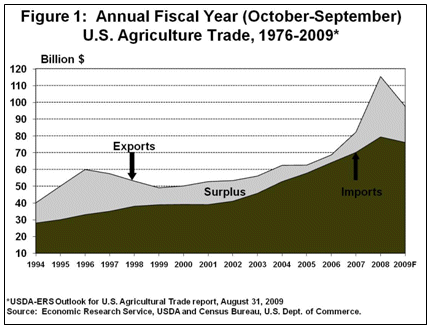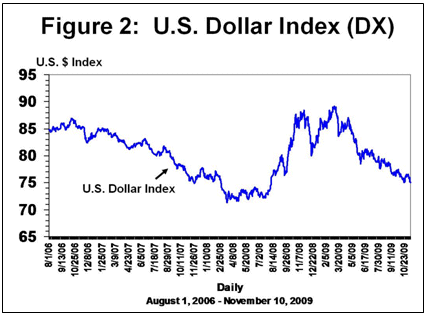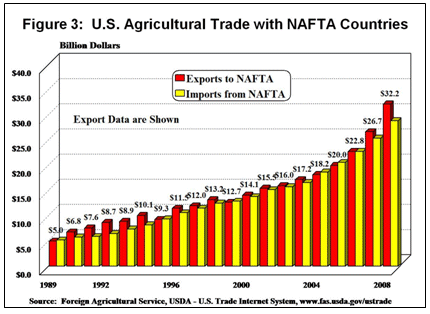Vol. 25, Issue 37, November 11, 2009 – PDF version
Jose G. Peña, Texas AgriLife Extension Economist-Management
The USDA-ERS, August 31, 2009, Outlook for U.S. Agricultural Trade report, estimated U.S. agricultural exports for FY 2009 at $97.0 billion, up $1.0 billion from USDA’s initial forecast, but down 15.9 percent from last year’s record exports of $115.3 billion. (See Figure 1) About two-thirds of last year’s record Ag export growth was due to high prices for most Ag commodities. Lower commodity prices account for part of the reduction in export value. The estimate of export volume for FY 2009 is up slightly (2.7%) from USDA’s initial estimate, but remains significantly below last year’s record high. USDA’s August estimate of imports is down $5 billion, thereby increasing the net trade balance to $21.5 billion, up 43 percent from the initial estimate of $15 billion.
USDA’s initial forecast of exports for FY 2010, however, at $97.0 is down $0.5 billion from FY 2009. Imports are forecast at $82.0 billion, up $6.0 billion from FY 2009, dropping the estimated trade balance to $15.0 billion, the same as USDA’s initial estimate for FY 2009.
It appears that the U.S. is sustaining its world trade market share and the prospects for increased trade may improve. Earlier this year, U.S. export trade slowed significantly as a result of the global recession and the appreciated value of the U.S. dollar. (See Figure 2) Now, lower commodity prices and a weaker U.S. dollar are encouraging export trade. The global recession has had a significant negative impact on trade. Signs of an improving global economy appear to be attracting investors and a weaker U.S. dollar may trigger higher-than-expected exports. While a weakening U.S. dollar aggravates the U.S. deficit/debt since more lowered valued dollars are required to re-pay debt incurred with higher valued dollars, a cheap U.S. dollar makes U.S. export commodities, such as corn, cotton, beef, etc., cheaper to overseas buyers. Increased export trade will help the economic recovery which appears underway. World demand for U.S. commodities remains relatively strong.
Increased grain and oilseed exports accounted for most of the $1 billion increase in export trade in FY 2009. USDA’s estimate of grain exports volumes was initially down sharply due to increased world competition, but stronger than expected late-season corn shipments and higher prices for rice reduced year-to-year decline. Soybean shipments reached a new record, reflecting strong Chinese demand and reduced competition.
But, export trade will remain relatively sluggish. For FY 2010, while USDA projects a slight increase of export sales of horticulture and livestock products, the export estimate of bulk products (wheat, rice, coarse grains, soybeans, cotton, and tobacco) is down slightly, due in part to a very slowly recovering global economy, uncertainty in the price of energy and the value of the dollar, which keeps fluctuating up/down as influenced by energy costs.
NAFTA
Meanwhile, trade with our two North American Free Trade Agreement (NAFTA) trading partners reached a record high last year as the implementation of the agricultural provisions of the agreement were fully implemented. In 2008, the last of NAFTA’s transitional restrictions governing U.S.-Mexico and Canada-Mexico agricultural trade were removed, concluding a 14-year project in which the member countries systematically dismantled numerous barriers to regional agricultural trade. During the implementation period, the agricultural sectors of Canada, Mexico, and the United States have become much more integrated.
Ag trade between the U.S., Mexico and Canada has increased over 300 percent since the early ‘90’s as Canadian and Mexican industries that rely on U.S. agricultural inputs have expanded. (See Figure 3) U.S. feedstuffs have facilitated a marked increase in Mexican meat production and consumption, and the importance of Canadian and Mexican produce to U.S. fruit and vegetable consumption is growing.
Canada and Mexico are the first and second largest export markets for U.S. agricultural products. Exports to the two markets in 2009 moved ahead of East Asia as the top destination for U.S. agricultural exports. Europe was a distant third.
U.S. agricultural exports to Mexico have more than tripled to about $16.0 billion in 2008, while exports to Canada increased about 360 percent, reaching $16.3 billion in 2008, up from $4.2 billion in 1990. Imports from Canada increased from $3.2 billion in 1989 to $18.0 billion in 2008. Fresh and processed fruits and vegetables, snack foods, and other consumer foods account for close to three-fourths of U.S. sales to Canada.
Appreciation is expressed to Dr. Parr Rosson, Extension Economist Director, Center for North American Studies for his contribution and to review this article.



